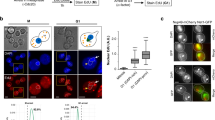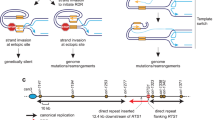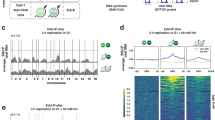Abstract
The halogenated thymidine (dT) analogue, 5-bromodeoxy-uridine (BUdR), has a variety of effects on mammalian cells, including toxicity, suppression of differentiation, and mutagenesis. Although it is generally assumed that the effects of BUdR are due primarily to its presence in DNA, results from our laboratory have raised doubts about such assumptions1–4. We have shown, for example, that BUdR mutagenesis in mammalian cells is determined by the concentration of BUdR in the medium rather than in DNA3, and that mutagenesis can be suppressed by deoxycytidine (dC) without changing the amount of BUdR in DNA4. BUdR has also been shown to induce sister chromatid exchanges (SCEs) in mammalian cells5–7. Initial results suggested that the relationship between BUdR and SCEs might not be explained by a single factor5, and various correlations between BUdR and SCEs have been proposed8,9. However, the results to date have been inconclusive, because the experiments did not resolve as independent variables the concentration of BUdR in the medium and the amount of BUdR incorporated into nuclear DNA. We have now carried out experiments to resolve these two factors; the results indicate that the major factor in determining the frequency of SCEs is the concentration of BUdR in the medium.
This is a preview of subscription content, access via your institution
Access options
Subscribe to this journal
Receive 51 print issues and online access
$199.00 per year
only $3.90 per issue
Buy this article
- Purchase on Springer Link
- Instant access to full article PDF
Prices may be subject to local taxes which are calculated during checkout
Similar content being viewed by others
References
Bick, M. D. & Davidson, R. L. Proc. natn. Acad. Sci. U.S.A. 71, 2082–2086 (1974).
Davidson, R. L. & Kaufman, E. R. Cell 12, 923–929 (1977).
Kaufman, E. R. & Davidson, R. L. Proc. natn. Acad. Sci. U.S.A. 75, 4982–4986 (1978).
Davidson, R. L. & Kaufman, E. R. Nature 276, 722–723 (1978).
Latt, S. Proc. natn. Acad. Sci. U.S.A. 71, 3162–3166 (1974).
Wolff, S. & Perry, P. Chromosoma 48, 341–353 (1974).
Kato, H. Nature 251, 70–72 (1974).
Stetka, D. G. & Carrano, A. V. Chromosoma 63, 21–31 (1977).
Mazrimas, J. A. & Stetka, D. G. Expl Cell Res. 117, 23–30 (1978).
Latt, S. Proc. natn. Acad. Sci. U.S.A. 43, 122–138 (1973).
Perry, P. & Wolff, S. Nature 251, 156–158 (1974).
Carrano, A. V., Thompson, L. H., Lindl, P. A. & Minkler, J. L. Nature 271, 551–553 (1978).
Ishii, Y. & Bender, M. Mutat. Res. 51, 411–418 (1978).
Kaufman, E. R. & Davidson, R. L. Somatic Cell Genet. 5, 653–663 (1979).
Davidson, R. L. & Kaufman, E. R. Somatic Cell Genet. 5, 873–885 (1979).
Meuth, M. & Green, H. Cell 2, 109–112 (1974).
Kaufman, E. R. & Davidson, R. L. Expl Cell Res. 107, 15–24 (1977).
Author information
Authors and Affiliations
Rights and permissions
About this article
Cite this article
Davidson, R., Kaufman, E., Dougherty, C. et al. Induction of sister chromatid exchanges by BUdR is largely independent of the BUdR content of DNA. Nature 284, 74–76 (1980). https://doi.org/10.1038/284074a0
Received:
Accepted:
Issue Date:
DOI: https://doi.org/10.1038/284074a0
This article is cited by
-
Super-resolution visualization and modeling of human chromosomal regions reveals cohesin-dependent loop structures
Genome Biology (2021)
-
Influence of low doses of BrdU and estimation of spontaneous SCE in CHO chromosomes: three-way differential staining and an immunoperoxidase method
Chromosoma (1992)
-
SCE variability in lymphocytes and fibroblasts
Human Genetics (1988)
-
Tumor cord and growth in human brain tumors based on mathematical morphology
Journal of Neuro-Oncology (1988)
-
Analysis of bromodeoxyuridine-induced single and twin sister chromatid exchanges in tetraploid Chinese hamster ovary cells
Chromosoma (1986)
Comments
By submitting a comment you agree to abide by our Terms and Community Guidelines. If you find something abusive or that does not comply with our terms or guidelines please flag it as inappropriate.



